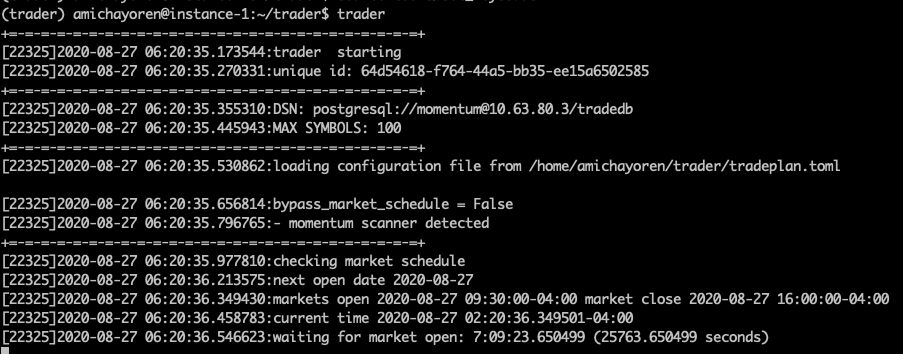Trading with Liu¶
LiuAlgoTrader has three applications and a set of analysis notebooks.
The applications are:
- trader
- backtester
- market_miner
This section describes the trader application,
No Liability Disclaimer¶
LiuAlgoTrader is provided with sample scanners and out-of-the-box strategies. You may choose to use it, modify it or completely disregard it - Regardless, LiuAlgoTrader and its Authors bare no responsibility to any possible loses from using LiuAlgoTrader, or any of its derivatives (on the other hand, they also won’t share your profits, if there are any).
trader¶
The trader application is the main application in the LiuAlgoTrading package and it runs algorithmic trading using the Alpaca Markets APIs.
Prerequisites¶
- Installed & configured PostgreSQL instance, hosting a database with LiuAlgoTrader schema,
- Ensuring environment variables are properly set including Alpaca Market API credentials, and the database DSN,
- An existing tradeplan.toml at the folder where the trader application is executed. For more details on how to setup the trade plan configuration file, see How to Configure section.
Trading session¶
Each run of the trader application generates a unique batch-id. The batch-id is displayed at the beginning of the execution of the trader application, as well as at the end of the session.
All trades done during a trade session (and based on the tradeplan defined in the tradeplan.toml file) are associated to a batch-id. This is important when analysing a trading day, or back-testing. When you back-test, you re-run a batch-id, simulating market condition while applying changes to the strategies being used.
Note: If a trading session is interrupted, the next run of the trader application will check for current open positions. If they exist, the trades done at the earlier session will be relocated to the new session - this is done in order to simplify trade session analysis. See the Analysis section for more information.
Off-hours¶
Once the day-trading ends, and all processes (scanners, consumers and producer) are done, off-hour tasks will run.
Currently supported tasks include:
- gain_loss : Populating gain_loss and trade_analysis DB tables with aggregated results per symbol, per algo_run_id.
Understanding trader output and Logging¶
The trader application writes output to STDOUT (standard output). It will also send logging to google-cloud-logging if configured. To learn more about how to configure this feature read the How to Install & Setup section.
The trader application uses a producer-consumers design patterns. In other words, when executed the scanners would run according to the specifications in tradeplan, and then a single producer process will spawn and a collection of consumer processes. To understand the inner workings read the Concepts section.
The trader application writes log outs in sections to help troubleshooting and for better readability.
- The first section presents the filename being executed (trader in most cases) followed by a unique-id (GUID) which represents the trading session. Each time the trader application is run, a new batch-id will be created. To understand more read the How to analyze your trades section.
- The second section displays non-secure environment variables that may affect the trading behaviour. You should see the DSN (database connection string) properly displayed, and when you don’t that’s normally a sign that the env variables were not properly set.
- The third section displays the location of the tradeplan file and parses its header. A basic validation of the tradeplan file is done during that point and error messages will be presented for crude formatting.
- The fourth section normally displays the scanner execution. For more details on scanners read the Scanners section.
- The fifth and last section displays the strategies execution. For more details on strategies read the Strategies section.
